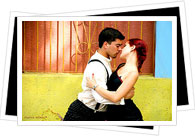
Tango is the most famous musical genre and dance style to come out of Argentina. The passionate rhythms and true expression created by the tango have had people around the world hooked for well over a century.
Argentine Tango today is an elegant and intimate creative style which many people associate with the upper classes and expensive black tie parties, where well dressed men and women take to the dance floor in a passionate embrace. If this is your opinion of tango you would not be mistaken. But it took many years for Tango to become as widespread as it is today. A dance of the aristocracy is certainly not all it is.
Tango began in the underclasses, born on the outskirts of Buenos Aires city, where men frequented brothels and bars where the only women present were prostitutes. Perhaps the physical liberation between prostitute and punter was the driving force behind the development of Tango in Argentina. In the 1880's socially accepted male-female relations were formal and the idea of a close embrace was unheard of, especially in public.
Tango broke the norms of forced, conservative group dancing and created a space for men and women to finally express themselves, flirt and be intimate. The dance began in the brothels backed by the melancholy notes of the accordian and the lyrics were characteristically crude and suggestive. Whilst male fans of the Tango could not find many women who would participate in such a scandolous dance, men began to develop the style together in the total absence of women.
The snobbish opinions of the aristocracy meant that tango remained popular only amongst the lower classes and eventually caught on with the large immigrant popualtion that was arriving in Buenos Aires by the boat-load, mainly made up of Spanish and Italians.
As Argentina got richer during the early twentieth century, influential 'artistes' from the upper classes like Richard Guiraldes began to make frequent trips to Europe, in particular, Paris. Tango underwent a severe cleaning up process to make it suitable for well-to-do Europeans and lyrics became less crass and less intimate forms of the tango were born where participants are not so close together. This cleaner form of Argentine Tango found immediate success in Paris and was soon to be found in the most reputable dance halls all around Europe.
This is where Tango met the tuxedo and the elegant sleek dresses that are associated with it today. The story of tango is a true sign of how much the Argentine aristocracy looked towards Europe for direction, - as soon as Tango became popualr in Europe, the upper class Argentines welcomed it back with open arms and began to don tuxedos in order to dance it too.
For the last century there really has been no stopping the Tango. Incredibly famous stars like Carlos Gardel have had the whole population mad with Tango fever - you can visit the grave of this famous tango crooner in the Cementerio de Chacarita in Buenos Aires. He was such an influential icon that his death caused women from Cuba to North America to attempt suicide, a true sign of how much Tango music has come to mean both inside and outside of Argentina. Constantly shrouded with flowers and gifts, Gardel's tombstone is a symbol of the importance of this musical genre to modern day Argentine culture.
Today, Tango in Argentina has become a diverse and eclectic mixture of modern trends and contemporary development. There are many different styles of Tango which have developed over the years in different areas depending on the space there was to dance and the fashions in the area. Tango Rock has become extremely popular and the rich sound of string instruments have been added like violins and doublebass to add more depth to the sound of the Tango.
Where Argentine Tango will go in the future is impossible to predict, but what is sure is that it is unlikely to fall from favour...